En industrias como minería, petróleo y gas, conformado de metales, carpintería, y en la fabricación, los materiales resistentes al desgaste son fundamentales.
Cuando el equipo opera en entornos difíciles, las piezas deben soportar la fricción, la presión, el calor y la corrosión. Dos de los materiales más comunes para piezas de desgaste Son carburo de tungsteno y acero.
Elegir el material adecuado puede afectar la productividad, los costos y el tiempo de inactividad. Este artículo compara el carburo de tungsteno con el acero en términos de rendimiento, costo, durabilidad y mejores aplicaciones, ayudando a los responsables de la toma de decisiones a seleccionar el material adecuado para sus operaciones.
¿Qué es el carburo de tungsteno?
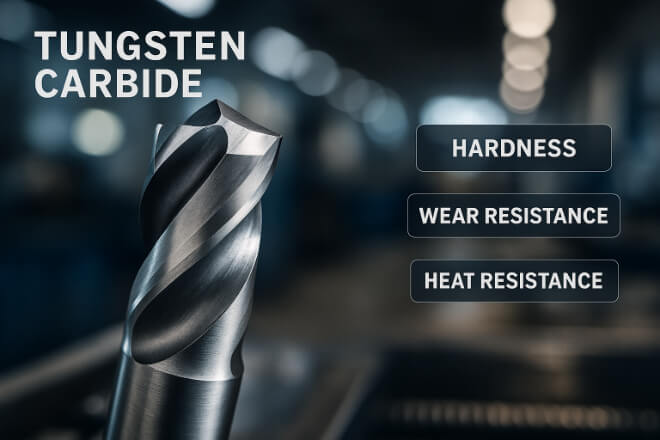
El carburo de tungsteno es un compuesto de átomos de tungsteno y carbono. Es extremadamente duro, casi tan duro como el diamante, y ofrece buena tenacidad.
Esto lo convierte en una opción ideal para piezas de desgaste que enfrentan abrasión constante o condiciones extremas.
Propiedades clave del carburo de tungsteno:
Muy alto dureza (8,5–9 en la escala de Mohs)
Excelente resistencia al desgaste
Alta resistencia al calor
Buena resistencia a la corrosión
Larga vida útil
Los usos comunes incluyen herramientas de corte, brocas para minería, sellos de bombas, revestimientos antidesgaste y matrices de precisión.
¿Qué es el acero?
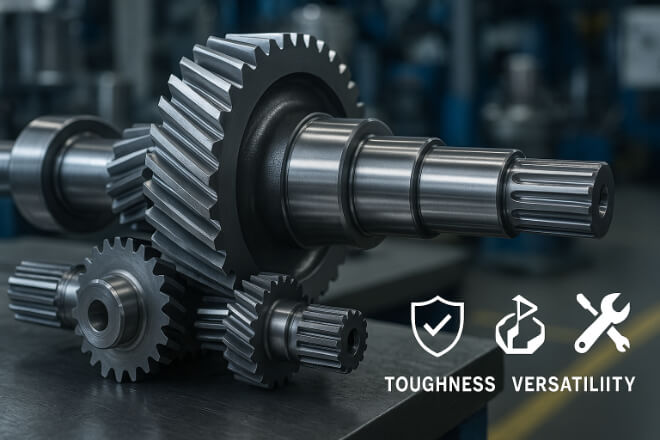
El acero es una aleación hecha principalmente de hierro y carbono, a menudo con otros elementos como cromo, níquel o manganeso para mejorar el rendimiento.
El acero es popular por su resistencia, dureza y versatilidad. Además, es más fácil y económico de mecanizar y soldar que el carburo de tungsteno.
Propiedades clave del acero:
Alto tenacidad y fuerza
Más fácil de mecanizar y dar forma.
Rentable para piezas grandes
Diferentes grados para diferentes usos (por ejemplo, acero para herramientas, acero inoxidable, acero con alto contenido de carbono)
El acero se utiliza ampliamente para engranajes, ejes, piezas estructurales y componentes de ingeniería general.
Carburo de tungsteno vs. acero: Comparación de propiedades
| Propiedad | Carburo de tungsteno | Acero |
|---|---|---|
| Dureza | Extremadamente alta (8,5–9 Mohs) | Inferior (4–8 Mohs, dependiendo del grado) |
| Resistencia al desgaste | Excelente, ideal para condiciones abrasivas. | Bueno, pero se desgasta más rápido con la abrasión. |
| Resistencia al calor | Muy alta, conserva la dureza a altas temperaturas. | Moderado, puede perder dureza a altas temperaturas. |
| Resistencia a la corrosión | Alto, especialmente con recubrimientos. | Varía: el acero inoxidable resiste bien la corrosión. |
| Tenacidad | Moderado (puede astillarse bajo impactos fuertes) | Alto, mejor para cargas de impacto. |
| Maquinabilidad | Difícil, requiere herramientas de diamante o carburo. | Fácil de mecanizar con herramientas estándar. |
| Costo | Más alto | Más bajo |
Durabilidad en condiciones adversas
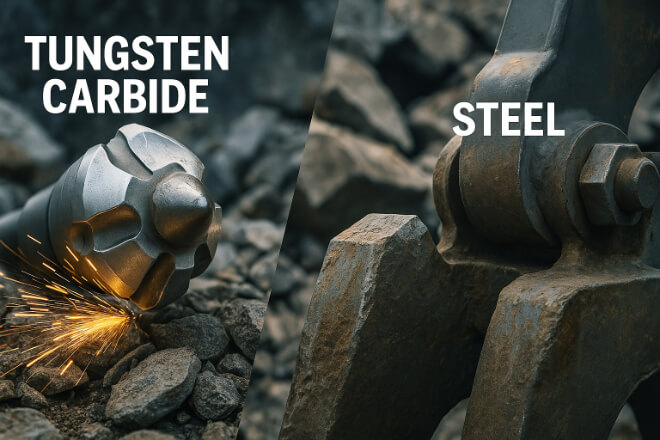
El carburo de tungsteno brilla cuando se trata de resistencia al desgaste y a la abrasión.
En minería o conformación de metales, las herramientas y componentes de carburo de tungsteno suelen durar de 3 a 10 veces más que sus equivalentes de acero. Esto reduce el tiempo de inactividad y los costos de reemplazo.
Sin embargo, el acero puede superar al carburo de tungsteno cuando las piezas están expuestas a fuertes impactos o fuerzas de flexión.
El acero es más alto tenacidad significa que puede absorber impactos sin agrietarse, lo que lo hace mejor para algunas aplicaciones estructurales.
Consideraciones de costos
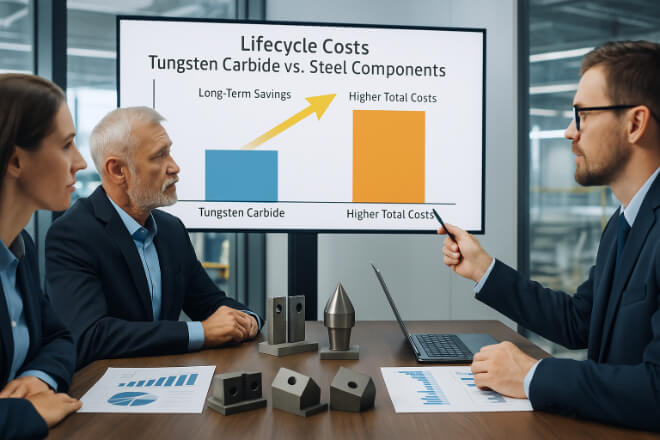
A primera vista, las piezas de carburo de tungsteno son más caras que las de acero. Sin embargo, si se considera el coste total del ciclo de vida —incluyendo reemplazos, tiempo de inactividad y mantenimiento—, el carburo de tungsteno suele ser más económico.
Por ejemplo, una matriz de corte de carburo de tungsteno puede costar 2 o 3 veces más que una matriz de acero, pero durar entre 5 y 10 veces más, lo que la convierte en una mejor inversión en muchos casos.
Adecuación de la aplicación
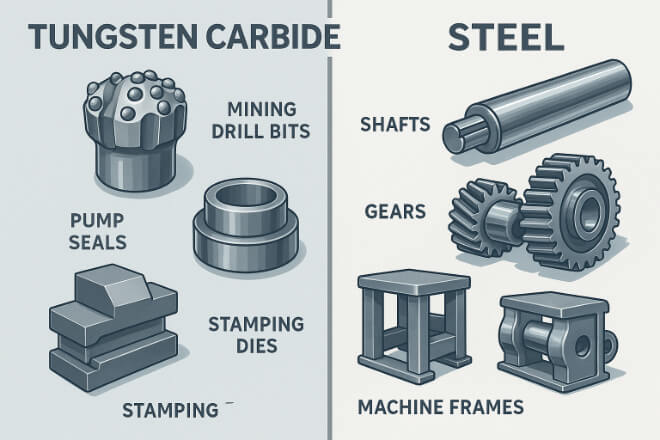
1) Cuándo utilizar carburo de tungsteno:
Desgaste y abrasión extremos
Altas temperaturas
Tolerancias de precisión
Funcionamiento continuo con un tiempo de inactividad mínimo permitido
1.1) Ejemplos:
brocas para minería
Sellos de la bomba en petróleo y gas
Matrices de estampación de metal
Hojas para trabajar la madera
2) Cuándo utilizar acero:
Cargas de impacto pesadas y flexión
Entornos de temperatura más baja
Aplicaciones donde el coste es un factor clave
Piezas grandes que serían demasiado caras en carburo.
2.1) Ejemplos:
Bastidores de máquinas
Ejes y engranajes
Componentes estructurales generales
Resumen de pros y contras
| Material | Ventajas | Contras |
|---|---|---|
| Carburo de tungsteno | Excelente resistencia al desgaste, alta dureza, buena resistencia al calor y a la corrosión, larga vida útil. | Caro, frágil ante fuertes impactos, difícil de mecanizar. |
| Acero | Alta tenacidad, menor costo, fácil de mecanizar, versátil. | Menor resistencia al desgaste, puede perder dureza a altas temperaturas, necesita más mantenimiento. |
Elegir entre carburo de tungsteno y acero
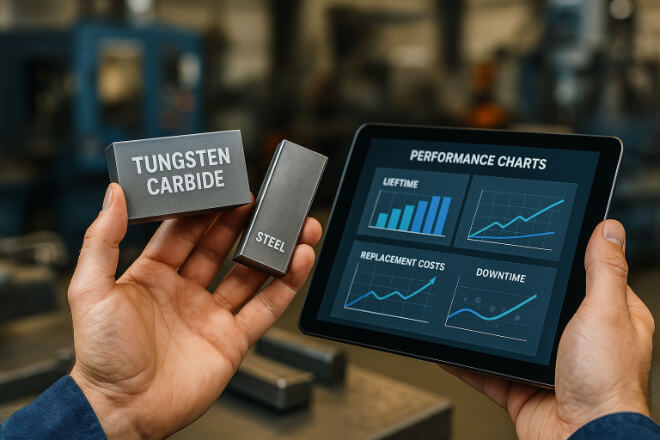
La selección del material adecuado depende de:
Tipo de desgaste: abrasivo, adhesivo, por impacto o corrosivo.
Temperatura de funcionamiento: los procesos de alta temperatura pueden requerir carburo.
Tamaño de la pieza: el acero es más económico para piezas grandes
Requisitos de vida útil: el carburo a menudo significa menos reemplazos
Presupuesto: planificación de costos a corto y largo plazo
Para muchas industrias, el mejor enfoque es una combinación: utilizar acero para soporte estructural y carburo de tungsteno para superficies de desgaste.
Consejos de mantenimiento para maximizar el rendimiento
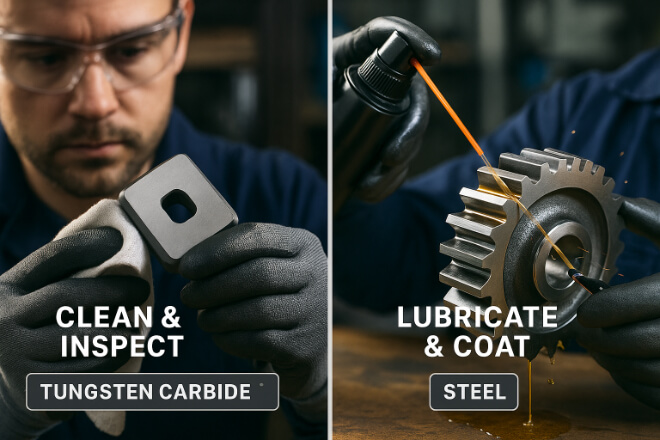
1) Para carburo de tungsteno:
Evite impactos repentinos
Utilice un montaje adecuado para evitar grietas por tensión
Limpiar periódicamente para evitar la corrosión causada por productos químicos.
2) Para acero:
Aplicar recubrimientos protectores para resistencia a la corrosión.
Mantener la lubricación para reducir el desgaste.
Compruebe periódicamente si hay grietas o deformaciones.
Conclusión
En el debate entre el carburo de tungsteno y el acero, no hay un ganador único. El carburo de tungsteno domina en resistencia al desgaste y aplicaciones de alta temperatura, mientras que el acero ofrece tenacidad y ventajas de costo para usos estructurales y de alto impacto.
Los responsables de la toma de decisiones deben sopesar el coste total de propiedad, las necesidades de rendimiento y las condiciones de funcionamiento. En muchos casos, la combinación de ambos materiales en un único sistema ofrece lo mejor de ambos mundos: durabilidad y resistencia.
Si desea conocer más detalles sobre alguna empresa, no dude en contactarnos. Contáctanos.
